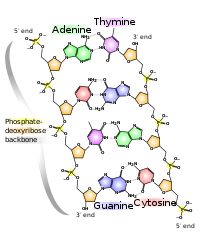
Photo from wikipedia
Prions are self-propagating protein isoforms that are typically amyloid. In Saccharomyces cerevisiae , amyloid prion aggregates are fragmented by a trio involving three classes of chaperone proteins: Hsp40s, also known… Click to show full abstract
Prions are self-propagating protein isoforms that are typically amyloid. In Saccharomyces cerevisiae , amyloid prion aggregates are fragmented by a trio involving three classes of chaperone proteins: Hsp40s, also known as J-proteins, Hsp70s, and Hsp104. Hsp104, the sole Hsp100-class disaggregase in yeast, along with the Hsp70 Ssa and the J-protein Sis1, is required for the propagation of all known amyloid yeast prions. However, when Hsp104 is ectopically overexpressed, only the prion [ PSI + ] is efficiently eliminated from cell populations via a highly debated mechanism that also requires Sis1. Recently, we reported roles for two additional J-proteins, Apj1 and Ydj1, in this process. Deletion of Apj1, a J-protein involved in the degradation of sumoylated proteins, partially blocks Hsp104-mediated [ PSI + ] elimination. Apj1 and Sis1 were found to have overlapping functions, as overexpression of one compensates for loss of function of the other. In addition, overexpression of Ydj1, the most abundant J-protein in the yeast cytosol, completely blocks Hsp104-mediated curing. Yeast prions exhibit structural polymorphisms known as “variants”; most intriguingly, these J-protein effects were only observed for strong variants, suggesting variant-specific mechanisms. Here, we review these results and present new data resolving the domains of Apj1 responsible, specifically implicating the involvement of Apj1’s Q/S-rich low-complexity domain.
Journal Title: Current Genetics
Year Published: 2019
Link to full text (if available)
Share on Social Media: Sign Up to like & get
recommendations!